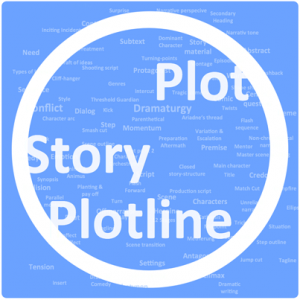Plot
A story is a sequence of events with beginning, middle and end.
In a plot, the events of a story are put into a dramatically effective order that does not have to correspond to the chronology.
A storyline is a story within a story – i.e. a story strand. In the course of the film these storylines become entangled in each other several times: they touch and cross each other, they connect and disconnect, they intertwine and overlie, they join and split again.
Most stories consist of a main plot as well as several secondary storylines in form of less complex secondary or sub-storylines. In episodic films storylines are almost coequal. Short films usually focus on a singular storyline.
The standard structure of a feature film consists of two main storylines: the A and the B storyline:
- The A(ction)-storyline harbours the main action of a story with its dominant external conflict and defines the story’s structure.
- The B-storyline stands for the need- or relationship-plot. Most of the time it focuses primarily on the dramatic ‘need‘ of the main character which is, for instance, developed through the love story. Usually it is closely linked to the A-storyline, while developing in the opposite direction.
- The remaining storylines tell sub-strands and are attributed according to their relevance for the film.
Storylines enrich a plot and make it multidimensional, by exposing ‘the other side of the medal’, providing motivations and adding details. Thereby they may expose the characters’ various attitudes, mentalities, facets and reactions. They investigate the protagonist’s conflict from different points of view or they can explore the plot from the point of view of a secondary character so that she becomes the main character of her sub-storyline.
Basically every character with her own ‘want‘ has her own storyline. The antagonist should always have his own storyline to show his milieu and explain his thoughts and motivation. Quite often the antagonist or the secondary main character or another important character have their own storyline. Furthermore each character relationship developing in the course of the film can be understood as a storyline: as a plot between these two characters within the overall plot. This way a film contains as many storylines as there are character relationships and conflicts.
Storylines may be quite different in their extent and importance. Too many storylines slow down the narrative because they reduce the overall narrative speed. Another risk of too many storylines is that they steal focus from the main plot and cause confusion.
Like the overall plot each storyline follows a dramatic structural arc. When using a closed story structure each storyline should be concluded with a closure as well as develop via its own turning points. These should be linked to the central turning points to ensure a structural and dramatic unity of the overall-plot. Therefore the DQ-Storytelling-Guidance is also quite suitable for the development of storylines.
Storylines should
- influence the main plot, intensify its effect or comment on its theme or subject matter (as long as there is a main plot).
- create a sense of a thematic unity by reflecting a variation of the main plot’s theme.
- show a different aspect of the main character.
- find closure or consolidation until the climax. Ideally all storylines are consolidated during the climax.
Without the existence of these relationships and links between the storylines there are only separate stories without a greater sense of unity.
Through the use of different storyline resolutions one has the chance to create an ambivalent film ending – i.e. to create an end that is neither clearly happy nor sad.
 Further reading
Further reading
Tobias, Ronald B.: 20 Master Plots: And How to Build Them. Cincinnati 2012.



Comments are closed.